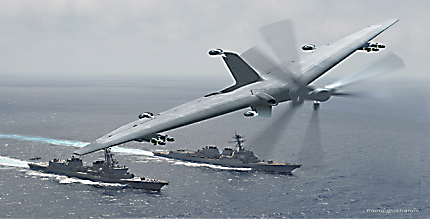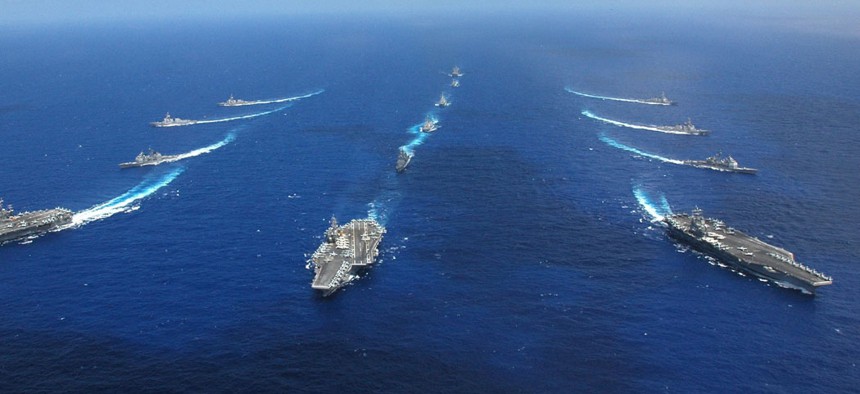Tern gets closer to extending ships' ISR reach at sea
The DARPA-ONR program to develop long-range, vertical-lift drones for smaller ships moves into Phase 3.

A DARPA illustration of Tern in flight.
The military has made extensive use of unmanned aircraft for surveillance and intelligence gathering, but long-range drones have always had one limitation—they require a runway, which means you need a ground-based airfield or aircraft carrier for them to take off and land from.
Pentagon researchers have been working to correct that, with a program to develop unmanned aircraft that combine the vertical takeoff and landing (VTOL) ability of helicopters with the ability to fly with the speed and endurance of a larger plane. The goal of the Tern program, a joint venture of the Defense Advanced Research Projects Agency and the Office of Naval Research, is to build an aircraft capable of working from a ship such as an Arleigh Burke-class destroyer, which has a couple helicopter pads but no runways. Researchers also are hoping that the program can save money, by allowing ships to host the aircraft without any significant modifications.
The program is now entering Phase 3, with DARPA’s announcement of a contract award to a team led by Northrop Grumman to build a full-scale demonstrator, DARPA said in an announcement. The first two phases of the program, handled by multiple contractors, focused on preliminary design and managing risk. The Phase 3 demonstrator will be a medium-altitude, long-range aircraft for use by forward-deployed ships, which would greatly increase their ISR (intelligence, surveillance and reconnaissance) capability.
Tern is expected to produce a tailsitting, flying-wing aircraft with twin counter-rotating propellers mounted in the nose. The propellers would lift the aircraft, move into position for horizontal flight, then operate again vertically upon landing.
Although the unmanned aerial systems developed under the Tern program would give Navy ships a new measure of ISR reach, the basic idea behind the program, in terms of flight, isn’t new. The Navy has sought VTOL capability from ships since World War II, DARPA said. In fact, the Tern demonstrator could resemble the Convair XFY-1 Pogo, a manned VTOL fighter the Navy designed in the 1950s but which never got past the prototype stage.
The Navy and DARPA are hoping that Tern can help bring the next stage of UAS technology into the future. “ONR’s and DARPA’s partnership on Tern continues to make rapid progress toward creating a new class of unmanned air system combining shipboard takeoff and landing capabilities, enhanced speed and endurance, and sophisticated supervised autonomy,” said Gil Graff, deputy program manager for Tern at ONR. “If successful, Tern could open up exciting future capabilities for Navy small-deck surface combatants and U.S. Marine Corps air expeditionary operations.”
Research into the Tern program also has produced a couple of spin-off technologies: a crane-like systems called SideArm that can launch and recover of UAS from ships, trucks or fixed ground facilities, and TALONS, which would allow a ship to tow an ISR system behind it at altitudes of 500 to 1,500 feet.
DARPA and ONR announced the joint project in June 2014, planning to build on a program DARPA had already started, called TERN, for Tactically Exploited Reconnaissance Node.




